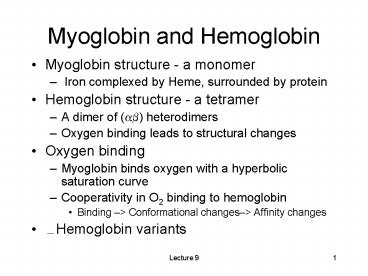Myoglobin and Hemoglobin - PowerPoint PPT Presentation
1 / 19
Title: Myoglobin and Hemoglobin
1
Myoglobin and Hemoglobin
- Myoglobin structure - a monomer
- Iron complexed by Heme, surrounded by protein
- Hemoglobin structure - a tetramer
- A dimer of (ab) heterodimers
- Oxygen binding leads to structural changes
- Oxygen binding
- Myoglobin binds oxygen with a hyperbolic
saturation curve - Cooperativity in O2 binding to hemoglobin
- Binding gt Conformational changesgt Affinity
changes - Hemoglobin variants
2
Myoglobin structure
- Globin
- 8 helices
- A (blue) to H (red)
- Protein segments (including sidechains)
completely surround the Heme.
3
Heme
- A porphyrin
- Held noncovalently
- Iron (II) ligated by 4 pyrrole nitrogens
- Histidine (below), the 5th ligand
- O2 binds above
- Color change on O2 binding
4
Oxygen Binding
- Heme ligation state is reflected by color change
- Oxygenation turns the heme red
- Oxygen saturation can be monitored by absorption
of visible light - A580 for Oxy myoglobin gt A580 for Deoxy Mb
5
Figure 7 Absorption spectra of O. bicornis Mb
Biochemical Journal www.biochemj.org
Biochem. J. (2005) 389, 497-505
6
Dissociation constants and concentrations
- A dissociation constant (Kd) governs the oxygen
dissociation reaction - MbO2 ltgt Mb O2
- Kd products/ reactants MbO2/MbO2
- Concentrations can be recast in terms of Kd
- Mb KdMbO2 /O2
- Dissociation constant ligand concentration at
half saturation - When Mb MbO2 Mb is 50 saturated
- Kd O2 p50
- O2 is proportional to partial pressure
- Chemical potentials are equal in the gas and
liquid phases
7
Saturation Curves
- The fractional saturation (Q) is a hyperbolic
function of O2 - Q oxygenated subunits /total subunits
- Q MbO2 / (Mb MbO2)
- Substituting KMbO2 /O2 for Mb
- Q MbO2 / (KMbO2 /O2 MbO2)
- Q 1 / (K /O2 1)
- Q O2 / (K O2)
8
Hemoglobin structure
- A dimer of heterodimers (ab)
- Oxygen binding leads to structural changes
- T state corresponds to deoxy form
- R state corresponds to oxygenated form
- Tertiary changes transmitted from heme gt His gt
helix F - Tertiary changes lead to quaternary shifts
between a1b1 and a2b2
9
Tertiary structure changes
10
(No Transcript)
11
Cooperativity
- Binding of one ligand affects the affinity for
the next. - Positive cooperativity
- If subsequent binding steps are very strong
relative to the first binding steps, ligand
saturation is essentially concerted. - Hb nO2 gt Hb(O2)n
- How many ligands bind in one event?
12
Hill plots and cooperativity estimates
- Assuming that binding is all or none, how many
ligands bind (or dissociate) at once? - For the reaction Hb(O2)n gt Hb n O2
- Kd (Hb O2n) / Hb(O2)n
- Y Hb(O2)n / HbT
- HbT Hb Hb(O2)n
- Rearranging the equilibrium expression
- Hb(O2)n /Hb O2n / Kd
- Substituting for Hb
- Hb(O2)n /(HbT - Hb(O2)n ) O2n / Kd
- Dividing by HbT gives
- Q / (1 - Q) O2n / Kd
- Log (Q / (1 - Q) ) n log O2 - log Kd
13
Hill plot of O2 binding to myoglobin and
hemoglobin
14
Cooperativity models
The sequential (Koshland)model Each subunit
undergoes 3 changes upon ligand binding R states
interact better with Rs
Monod-Wyman-Changeaux T and R are 4 states all
or none R states bind tighter
15
Allostery
- Allosteric proteins can exist in 2 conformational
states (often denoted T and R) - States differ in ligand affinity or enzymatic
activity - Conformational changes in tertiary structure and
can also be in quaternary contacts - Effector binding shifts the distribution of
states - Homotropic effectors (binding of one ligand or
substrate affects the binding of the next of the
same type) - Heterotropic effectors (different than the ligand
or substrate)
16
Allosteric Effectors
Small molecule binding can affect the energetics
of the T to R transition Increasing pH increases
O2 affinitiy The Bohr effect CO2 decreases pH BPG
binds to deoxy hemoglobin decreases O2 affinity
17
Hemoglobin physiology
High H
Low H
18
Hemoglobin variants
- 1 in 20 people has a variant hemoglobin
- Most are silent, single amino acid changes
- Some can cause real problems
- Thallesemias
- Sickle cell anemia
- Deoxy form polymerizes at low pH
- Sickled erythrocytes dont flow very well
- Adaptation to malaria
19
A single amino acid change is responsible for
sickle cell anemia































